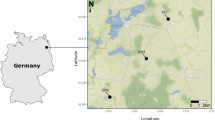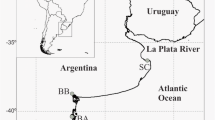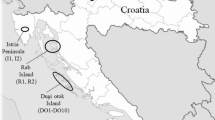Abstract
The present study aimed to determine zooplankton diversity and composition through a laboratory simulation of dispersal by morphologically different birds’ feet (large, small and webbed anisodactylous feet) and by comparing them between different water accumulation phases. We hypothesized that large anisodactylous birds, because of their larger size, can disperse a higher number of species. A laboratory experiment with zooplankton dispersal simulation by birds’ feet was carried out, using dry sediments collected at different past phases of water accumulation in a temporary pond, which represent the flood (upper egg bank) and drought (lower egg bank), intending to evaluate differences in species richness between these phases. The lower egg bank showed higher species richness (42 species) while the samples from upper egg banks presented almost the same number of species (35 or 36 at each one). The number of eggs carried on each footprint model (treatment) was different, and it was higher for large anisodactyl feet with 46 species, supporting the hypothesis of the study. Furthermore, the species compositions carried by footprint models were different from one other. In addition, some species were specific from each footprint model. We conclude that birds can disperse a large number of dormant zooplankton, acting in the dissemination of local species.




Similar content being viewed by others
References
Almeida VLS, Larrazabal MEL, Moura AN, Melo Júnior M (2006) Rotifera das Zonas Limnética e Litorânea do Reservatório de Tapacurá, Pernambuco, Brasil. Iheringia Sér Zool 96:445–451. https://doi.org/10.1590/S0073-47212006000400009
Amezaga JM, Santamaría L, Green AJ (2002) Biotic wetland connectivity—supporting a new approach for wetland policy. Acta Oecol 23:213–222. https://doi.org/10.1016/S1146-609X(02)01152-9
Anderson MJ, Walsh DCI (2013) Permanova, Anosim, and the Mantel test in the face of heterogeneous dispersions: what null hypothesis are you testing? Ecol Monogr 83:557–574. https://doi.org/10.1890/12-2010.1
Battauz YS, Paggi SBJ, Paggi JC (2014) Passive zooplankton community in dry littoral sediment: reservoir of diversity and potential source of dispersal in a subtropical floodplain lake of the Middle Paraná River (Santa Fe, Argentina). Int Rev Hydrobiol 99:277–286. https://doi.org/10.1002/iroh.201301670
Benjamini Y, Hochberg Y (1995) Controlling the false discovery rate: a practical and powerful approach to multiple testing. J R Stat Soc B 57:289–300. http://www.jstor.org/stable/2346101
Brito SL, Maia-Barbosa PM, Pinto-Coelho RM (2011) Zooplankton as an indicator of trophic conditions in two large reservoirs in Brazil. Lakes Reserv Res Manag 16:253–264. https://doi.org/10.1111/j.1440-1770.2011.00484.x
Brito MTS, Nascimento-Filho S, Almeida VLS, Neumann-Leitão S, Melo-Júnior M (2017) Zooplankton assemblages under drought period stressors in two reservoirs from semi-arid Brazil. Fund Appl Limnol 191:99–110. https://doi.org/10.1127/fal/2017/1060
Brochet AL, Gauthier-Clerc M, Guillemain M, Fritz H, Waterkeyn A, Baltanás Á, Green AJ (2010) Field evidence of dispersal of branchiopods, ostracods and bryozoans by teal (Anas crecca) in the Camargue (southern France). Hydrobiologia 637:255–261. https://doi.org/10.1007/s10750-009-9975-6
Brock MA, Nielsen DL, Shiel RJ, Green JD, Langley JD (2003) Drought and aquatic community resilience: the role of eggs and seeds in sediments of temporary wetlands. Freshw Biol 48:1207–1218. https://doi.org/10.1046/j.1365-2427.2003.01083.x
Cáceres CE (1998) Interspecific variation in the abundance, production, and emergence of Daphnia diapausing eggs. Ecology 79:1699–1710. https://doi.org/10.1890/0012-9658(1998)079%5b1699:IVITAP%5d2.0.CO;2
Cáceres CE, Soluk DA (2002) Blowing in the wind: a field test of overland dispersal and colonization by aquatic invertebrates. Oecologia 131:402–408. https://doi.org/10.1007/s00442-002-0897-5
Carvalho GR, Wolf HG (1989) Resting eggs of lake-Daphnia I. Distribution, abundance and hatching of eggs collected from various depths in lake sediments. Freshw Biol 22:459–470. https://doi.org/10.1111/j.1365-2427.1989.tb01118.x
Chao A, Jost L (2012) Coverage-based rarefaction and extrapolation: standardizing samples by completeness rather than size. Ecology 93:2533–2547. https://doi.org/10.1890/11-1952.1
Chao A, Gotelli NJ, Hsieh TC, Sander EL, Ma KH, Colwell RK, Ellison AM (2014) Rarefaction and extrapolation with Hill numbers: a framework for sampling and estimation in species diversity studies. Ecol Monogr 84:45–67. https://doi.org/10.1890/13-0133.1
Charalambidou I, Ketelaars HAM, Santamaría L (2003) Endozoochory by ducks: influence of developmental stage of Bythotrephes diapause eggs on dispersion probability. Divers Distrib 9:367–374. https://doi.org/10.1046/j.1472-4642.2003.00026.x
Cohen GM, Shurin JB (2003) Scale-dependence and mechanisms of dispersal in freshwater zooplankton. Oikos 103:603–617. https://doi.org/10.1034/j.1600-0706.2003.12660.x
Colwell RK, Chao A, Gotelli NJ, Lin SY, Mao CX, Chazdon RL, Longino JT (2012) Models and estimators linking individual-based and sample-based rarefaction, extrapolation and comparison of assemblages. J Plant Ecol 5:3–21. https://doi.org/10.1093/jpe/rtr044
Coughlan NE, Kelly TC, Davenport J, Jansen MAK (2017) Up, up and away: bird-mediated ectozoochorous dispersal between aquatic environments. Freshw Biol 62:631–648. https://doi.org/10.1111/fwb.12894
Darwin C (1859) On the origin of species by means of natural selection. John Murray, London
De Stasio BT (1989) The seed bank of a freshwater crustacean: copepodology for the plant ecologist. Ecology 70:1377–1389. https://doi.org/10.2307/1938197
Diniz LP, Elmoor-Loureiro LMA, Almeida VLS, Melo Júnior M (2013) Cladocera (Crustacea, Branchiopoda) of a temporary shallow pond in the Caatinga of Pernambuco, Brazil. Nauplius 21:65–78. https://doi.org/10.1590/S0104-64972013000100008
Dodson S (1992) Predicting crustacean zooplankton species richness. Limnol Oceanogr 37:848–856. https://doi.org/10.4319/lo.1992.37.4.0848
Duggan I, Green JD, Shiel RJ (2001) Distribution of rotifers in North Island, New Zealand, and their potential use as bioindicators of lake trophic state. Hydrobiologia 446:155–164. https://doi.org/10.1023/A:1017503407240
Elmoor-Loureiro LMA (1997) Manual de Identificação de Cladóceros Límnicos do Brasil. Universa, Brasília
Farias GB, Silva WAG, Albano CG (2005) Diversidade de aves em áreas prioritárias para conservação da Caatinga. In: Araújo FS, Rodal MJ, Barbosa MRV (eds) Análise das variações da biodiversidade do bioma caatinga: suporte e estratégias regionais de conservação. MMA, Brasília, pp 203–226
Figuerola J, Green AJ (2002a) How frequent is external transport of seeds and invertebrate eggs by waterbirds? A study in Doñana, SW Spain. Arch Hydrobiol 155:557–565. https://doi.org/10.1127/archiv-hydrobiol/155/2002/557
Figuerola J, Green AJ (2002b) Dispersal of aquatic organisms by waterbirds: a review of past research and priorities for future studies. Freshw Biol 47:483–494. https://doi.org/10.1046/j.1365-2427.2002.00829.x
Figuerola J, Green AJ, Michot TC (2005) Invertebrate eggs can fly: evidence of waterfowl-mediated gene flow in aquatic invertebrates. Am Nat 165:274–280. https://doi.org/10.1086/427092
Gerhard M, Iglesias C, Clemente JM, Goyenola G, Meerhoff M, Pacheco JP, Teixeira-de-Mello F, Mazzeo N (2017) What can resting egg banks tell about cladoceran diversity in a shallow subtropical lake? Hydrobiologia 798:75–86. https://doi.org/10.1007/s10750-016-2654-5
Gotelli NJ, Colwell RK (2001) Quantifying biodiversity: procedures and pitfalls in the measurement and comparison of species richness. Ecol Lett 4:379–391. https://doi.org/10.1046/j.1461-0248.2001.00230.x
Grebelnyi SD (1996) Influence of parthenogenetic reproduction on the genotypic constitution evolutionary success of populations and species. Hydrobiologia 320:55–61. https://doi.org/10.1007/BF00016804
Green AJ, Elmberg J (2014) Ecosystem services provided by waterbirds. Biol Rev 89:105–122. https://doi.org/10.1111/brv.12045
Green AJ, Figuerola J, Sánchez MI (2002) Implications of waterbird ecology for the dispersal of aquatic organisms. Acta Oecol Int J Ecol 23:177–189. https://doi.org/10.1016/S1146-609X(02)01149-9
Grönroos M, Heino J, Siqueira T, Landeiro VL, Kotanen J, Bini LM (2013) Metacommunity structuring in stream networks: roles of dispersal mode, distance type, and regional environmental context. Ecol Evol 3:4473–4487. https://doi.org/10.1002/ece3.834
Harvey PH, Colwell RK, Silvertown JW, May RM (1983) Null models in ecology. Annu Rev Ecol Syst 14:189–211
Hervé M (2008) RVAideMemoire: testing and plotting procedures for biostatistics. R package, version 0.9-69-3
Hsieh TC, Ma KH, Chao A (2016) iNEXT: an R package for rarefaction and extrapolation of species diversity (Hill numbers). Methods Ecol Evol 7:1451–1456. https://doi.org/10.1111/2041-210X.12613
Incagnone G, Marrone F, Barone R, Robba L, Naselli-Flores L (2015) How do freshwater organisms cross the “dry ocean”? A review on passive dispersal and colonization processes with a special focus on temporary ponds. Hydrobiologia 750:103–123. https://doi.org/10.1007/s10750-014-2110-3
Kirillova IV, Kotov AA, Trofimova SS, Zanina OG, Lapteva EG, Zinoviev EV, Chernova OF, Fadeeva EO, Zharov AA, Shidlovskiy FK (2015) Fossil fur as a new source of information on the Ice Age biota. Dokl Biol Sci 460:48–51. https://doi.org/10.1134/S0012496615010147
Koste W (1978) Rotatória: die Rädertiere Mitteleroupas Ein Bestimmungswerk begrüdet von Max Voigt. Uberordnung Monogonta. Gebrüder Borntraeger, Stuttgart
Leal IR, Tabzarelli M, Silva JMC (2003) Ecologia e Conservação da Caatinga. Universitária da UFPE, Recife
Lopes PM, Bozelli R, Bini LM, Santangelo JM, Declerck SAJ (2016) Contributions of airborne dispersal and dormant propagule recruitment to the assembly of rotifer and crustacean zooplankton communities in temporary ponds. Freshw Biol 61:658–669. https://doi.org/10.1111/fwb.12735
Lyra-Neves RM, Telino-Júnior WR (2010) Aves da Fazenda Tamanduá. Avis Brasilis, Vinhedo
Martens K, Behen F (1994) A checklist of the recent non-marine ostracods (Crustacea, Ostracoda) from the inland waters of South America and adjacent islands. Trav Sci Du Mus Natl D’Hist Nat Luxemb 22:1–81
Matsumura-Tundisi T (1986) Latitudinal distribution of Calanoida copepods in freshwater aquatic systems of Brazil. Rev Bras Biol 46:527–553
Morais-Junior CS, Melo-Junior M, Gonçalves-Souza T, Lyra-Neves RM (2019) Zoochory of zooplankton: seasonality and bird morphological diversity can influence metacommunity dynamics of temporary ponds. J Plankton Res. https://doi.org/10.1093/plankt/fbz028
Muñoz J, Felicísimo AM, Cabezas F, Burgaz A, Martínez I (2004) Wind as a long-distance dispersal vehicle in the Southern Hemisphere. Science 304:1144–1147. https://doi.org/10.1126/science.1095210
Neves RML, Telino-Júnior WR (2010) As aves da Fazenda Tamanduá. Avis Brasilis, Vinhedo
Oksanen J, Blanchet FG, Friendly M, Kindt R, Legendre P, McGlinn D, Minchin PR, O'Hara RB, Simpson GL, Solymos P, Stevens MHH, Szoecs E, Wagner H (2016) Vegan: community ecology package
Olmos F, Silva WAG, Albano CG (2005) Aves em oito áreas de caatinga no sul do Ceará e oeste de Pernambuco, nordeste do Brasil: composição, riqueza e similaridade. Pap Avulsos Zool 45:179–199. https://doi.org/10.1590/S0031-10492005001400001
R Core Team (2016) R: a language and environment for statistical computing. R Foundation for Statistical Computing. Vienna. http://www.r-project.org. Accessed 29 Aug 2019
Reid JW (1985) Chave de identificação e lista de referências bibliográficas para espécies continentais sul-americanas de vida livre da ordem Cyclopoida (Crustacea, Copepoda). Bol Zool 9:17–143. https://doi.org/10.11606/issn.2526-3358.bolzoo.1985.122293
Reynolds C, Miranda NAF, Cumming GS (2015) The role of waterbirds in the dispersal of aquatic alien and invasive species. Divers Distrib 21:744–754. https://doi.org/10.1111/ddi.12334
Roos AL, Nunes MFC, Sousa EA, Sousa AEBA, Nascimento JLX, Lacerda RCA (2006) Avifauna da região do Lago de Sobradinho: composição, riqueza e biologia. Ornithology 1:135–160
Santangelo JM, Araújo LR, Esteves FA, Manca M, Bozelli RL (2011) Method for hatching resting eggs from tropical zooplankton: effects of drying or exposing to low temperatures before incubation. Acta Limnol Bras 23:42–47. https://doi.org/10.4322/actalb.2011.017
Santos EM, Melo-Júnior M, Silva-Cavalcanti JS, Almeida GVL (2013) Parque Estadual Mata da Pimenteira: Riqueza Natural e Conservação da Caatinga. Universidade Federal Rural de Pernambuco, Recife
Schabetsberger R, Drozdowski G, Rott E, Lenzenweger R, Jersabek CD, Fiers F, Traunspurger W, Reiff N, Stoch F, Kotov AA, Martens K, Schatz H, Kaiser R (2009) Losing the bounty? Investigating species richness in isolated freshwater ecosystems of Oceania. Pac Sci 63:153–179. https://doi.org/10.2984/049.063.0201
Sick H (1997) Ornitologia brasileira. Nova Fronteira, Rio de Janeiro
Simonis JL, Ellis JC (2014) Bathing birds bias b-diversity: frequent dispersal by gulls homogenizes fauna in a rock-pool metacommunity. Ecology 95:1545–1555. https://doi.org/10.1890/13-1185.1
Smirnov NN (1996) Cladocera: the Chydoridae and Sayciinae (Chydoridae) of the word. SPB Academic Publishing, Amsterdam
Sousa FDR, Elmoor-Loureiro LMA (2008) Cladóceros fitófilos (Crustacea, Branchiopoda) do Parque Nacional das Emas, estado de Goiás. Biota Neotrop 8:159–166. https://doi.org/10.1590/S1676-06032008000100019
Ulrich W, Gotelli NJ (2007) Null model analysis of species nestedness patterns. Ecology 88:1824–1831. https://doi.org/10.1890/06-1208.1
Van Damme K, Sinev AY, Dumont HJ (2011) Separation of Anthalona gen.n. from Alona Baird, 1843 (Branchiopoda: Cladocera: Anomopoda): morphology and evolution of scraping stenothermic alonines. Zootaxa 2875:1–64
Vandekerkhove J, Declerck S, Jeppesen E, Conde-Porcuna JM, Brendonck L, De Meester L (2005) Dormant propagule banks integrate spatio-temporal heterogeneity in cladoceran communities. Oecologia 142:109–116. https://doi.org/10.1007/s00442-004-1711-3
Vanschoenwinkel B, De Vries C, Seaman M, Brendonck L (2007) The role of metacommunity processes in shaping invertebrate rock pool communities along a dispersal gradient. Oikos 116:1255–1266. https://doi.org/10.1111/j.0030-1299.2007.15860.x
Vanschoenwinkel B, Gielen S, Seaman M, Brendonck L (2008a) Any way the wind blows—frequent wind dispersal drives species sorting in ephemeral aquatic communities. Oikos 117:125–134. https://doi.org/10.1111/j.2007.0030-1299.16349.x
Vanschoenwinkel B, Gielen S, Vandewaerde H, Seaman M, Brendonck L (2008b) Relative importance of different dispersal vectors for small aquatic invertebrates in a rock pool metacommunity. Ecography 31:567–577. https://doi.org/10.1111/j.0906-7590.2008.05442.x
Vanschoenwinkel B, Waterkeyn A, Nhiwatiwa T, Pinceel T, Spooren E, Geerts A, Clegg B, Brendonck L (2011) Passive external transport of freshwater invertebrates by elephant and other mud-wallowing mammals in na African savannah habitat. Freshw Biol 56:1606–1619. https://doi.org/10.1111/j.1365-2427.2011.02600.x
Wallace RL, Snell TW, Ricci C, Nogrady T (2006) Rotifera: biology, ecology and systematics. Backhuys, Leiden
Acknowledgements
We thank the Academic Unity of Serra Talhada (UFRPE, Brazil) for logistic support in implementing this study, and would also like to express our gratitude to Professor Ricardo Lourenço Pinto, of the University of Brasilia (Brazil) and to Professor Sigrid Neumann Leitão, of the Federal University of Pernambuco (Brazil), for helping in Ostracoda and Rotifera identification, respectively. We also thank to CAPES and CNPq, for the financial support to the first and second authors. This project was supported by the Foundation for Science and Technology of the State of Pernambuco-FACEPE (#APQ-0664-2.05/10).
Author information
Authors and Affiliations
Corresponding author
Additional information
Publisher's Note
Springer Nature remains neutral with regard to jurisdictional claims in published maps and institutional affiliations.
Electronic supplementary material
Below is the link to the electronic supplementary material.
Rights and permissions
About this article
Cite this article
de Morais Junior, C.S., Diniz, L.P., Sousa, F.D.R. et al. Bird feet morphology drives the dispersal of rotifers and microcrustaceans in a Neotropical temporary pond. Aquat Sci 81, 69 (2019). https://doi.org/10.1007/s00027-019-0666-8
Received:
Accepted:
Published:
DOI: https://doi.org/10.1007/s00027-019-0666-8




